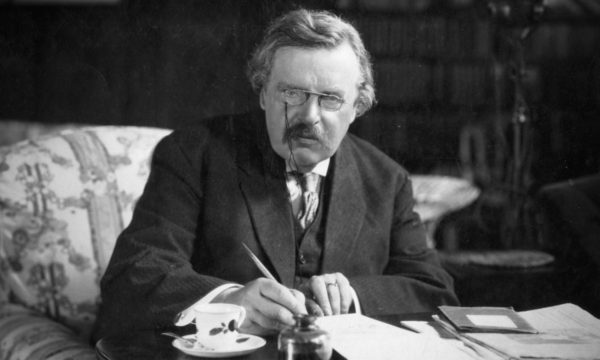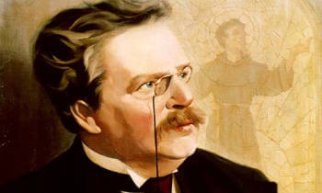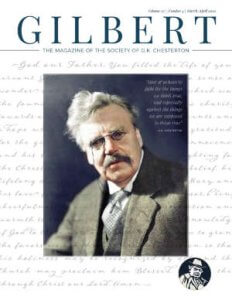When the Great War ended, it didn’t end. That is why it would later be known as World War I.
G.K. Chesterton argued that the armistice of 1918 was not a peace, but a truce. Less than fifteen years later, he saw that the truce was crumbling, that the world was headed towards a new war, a horrible war, worse than the first, and that it would start on the Polish border. He did not live to see his predictions come true. But his publisher, Frank Sheed, did see the frightful fulfillment of Chesterton’s prophecies, prompting him to remark: “Now when a man is as right as that in his forecasts, there is some reason to think he may be right in his premises.”
As the Great War, Part Two, commenced, Frank Sheed compiled some Chesterton essays, drawn primarily from G.K.’s Weekly, and laid them out in a perfect order so that it looks like Chesterton himself had designed this to be a book. But as Sheed indicates in his introduction, Chesterton’s essays “form a unity because of the unity in his own mind.’
The prophecies come fast and faster as Chesterton not only predicts the outbreak of the new war but many things that would happen after the war, including events in our own day. “The outlook in Europe is dark,” he writes, “And it looks as if the Pacifists will succeed in dragging us all into War.” By Pacifists, he means the internationalists who want to create an artificial “union” of nations, denying them their autonomy and national character, under the illusion that this will do away with hostilities. Chesterton says it will only create hostilities, and it will be the internationalists intervening with force into every other nation. Internationalism is against nations. In Chesterton’s time it was the League of Nations. In our time it is the United Nations and European Union.
The internationalists in Chesterton’s time were pathetically trying to pacify two empires that were growing into monsters. The first of these was Nazi Germany (which according to Chesterton was nothing more than a continuation of the Prussian empire), the second was the Soviet Union. The rest of Europe and America watched in a sort of daze as these two beasts devoured Poland.
Chesterton blasts both the Liberals, who are enthusiastic towards a universal Communism, “their enthusiasm being tinged with euthanasia,” and the Conservatives, who are “old men bullying young men by roaring in a raucous voice that all foreigners are fools.” The hatred of Poland, he says, was, in essence, the hatred of Christianity.
The most interesting and most chilling part of this volume is Chesterton’s view of Hitler. He starts out with the rather plainspoken remark that the stupidest thing done in the last two or three centuries was the acceptance by the Germans of the Dictatorship of Hitler. The desire for the strong man, as Chesterton had long pointed out, is itself a sign of weakness, and a system built on the strong man is one that cannot be sustained.
The growth of Protestantism in Germany led to a strange and steady distancing from the universal Church of Christendom and an embrace of Old Testament ideas, particularly the ancient story of the Covenant with Israel. Thus the Germans grew more and more into the mood of seeing their religion as a mystical religion of Race. Inflamed by the rhetoric of Hitler, they began to see themselves as the new Chosen People, an irony Chesterton sums up as “The Judaism of Hitler.”
It was not nationalism, which Chesterton says is the “the recognition of traditional frontiers.” The religion of Race was “Anthropology gone mad.” It means “everlastingly looking for your own countrymen in other people’s countries.”
Chesterton says the cult of race has two downfalls. The first and most obvious is the tendency towards pride. The second he calls “The Indefinite.” Though the Cult insists on racial purity, races are not pure; there are too many variations with no clear definitions. It is, says Chesterton, an “ordeal by blood: the blood test.”
Ironically, it is the same problem encountered by Bob Jones University (see page XX). Both Hitler and Bob Jones fell for the fallacy of racial purity – Hitler using Darwin by way of Nietzsche, Bob Jones using the Curse of Ham (Gen.9:20-27). Both attacked the Catholic doctrine of free will and in turn attacked the Catholic Church. They were not protecting a tradition, but they were protecting something that had gone wrong in a tradition. ‘The problem is a problem of human will; of human motives and morals, and therefore of human souls.” In the case of Hitler, the ordeal by blood test led to the bloodiest war in history and unspeakable acts against millions of Jews, Catholics, and others in the Nazi death camps.
Though Chesterton’s analysis of Hitler and the Nazis is prophetic and pointed, condemning what happened even before it happened, his remarks are balanced by some sobering words for the rest of us: “It will be well before criticising another people, to make it a sort of religious exercise to remember what could be said against our own people.”





